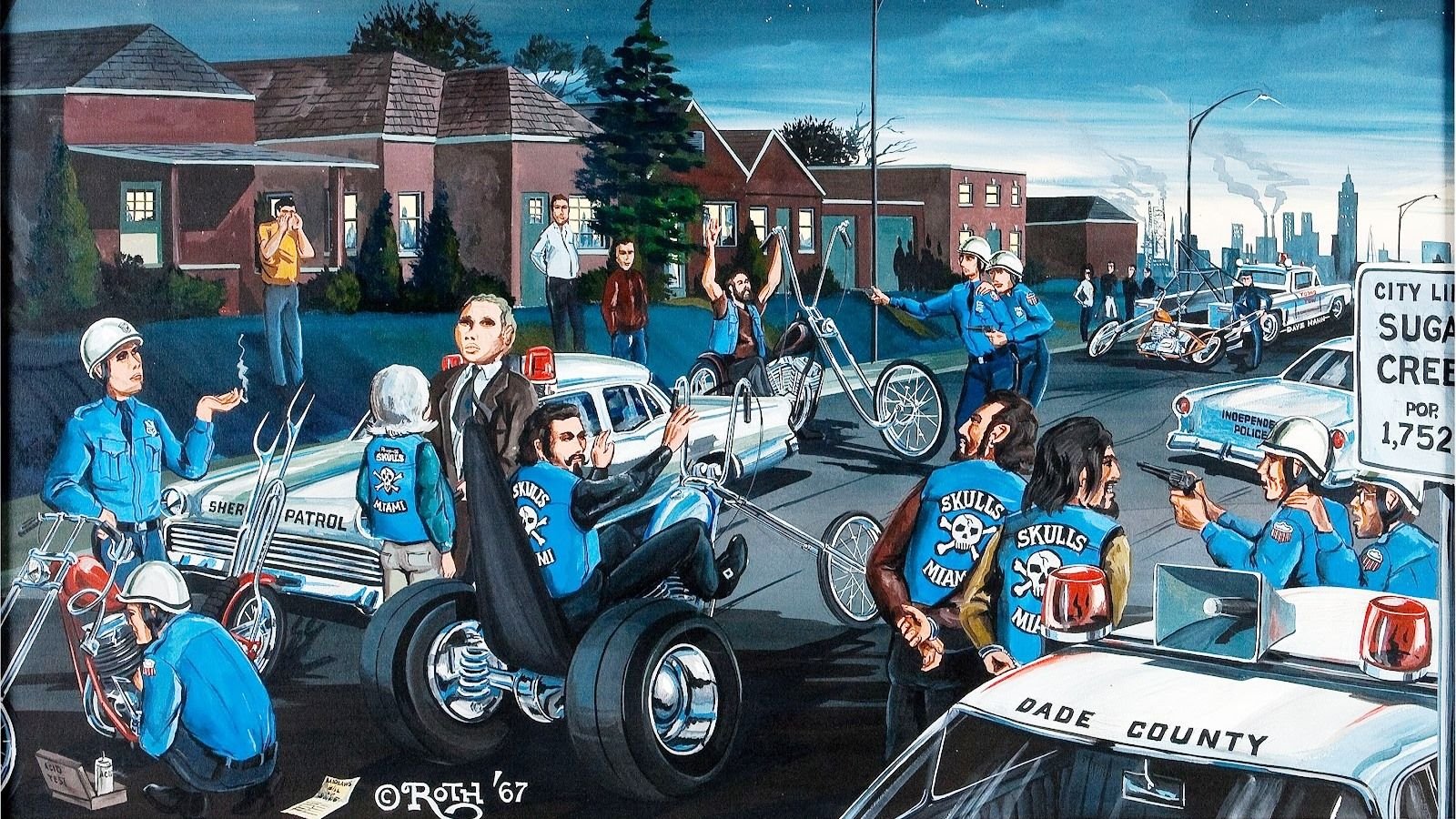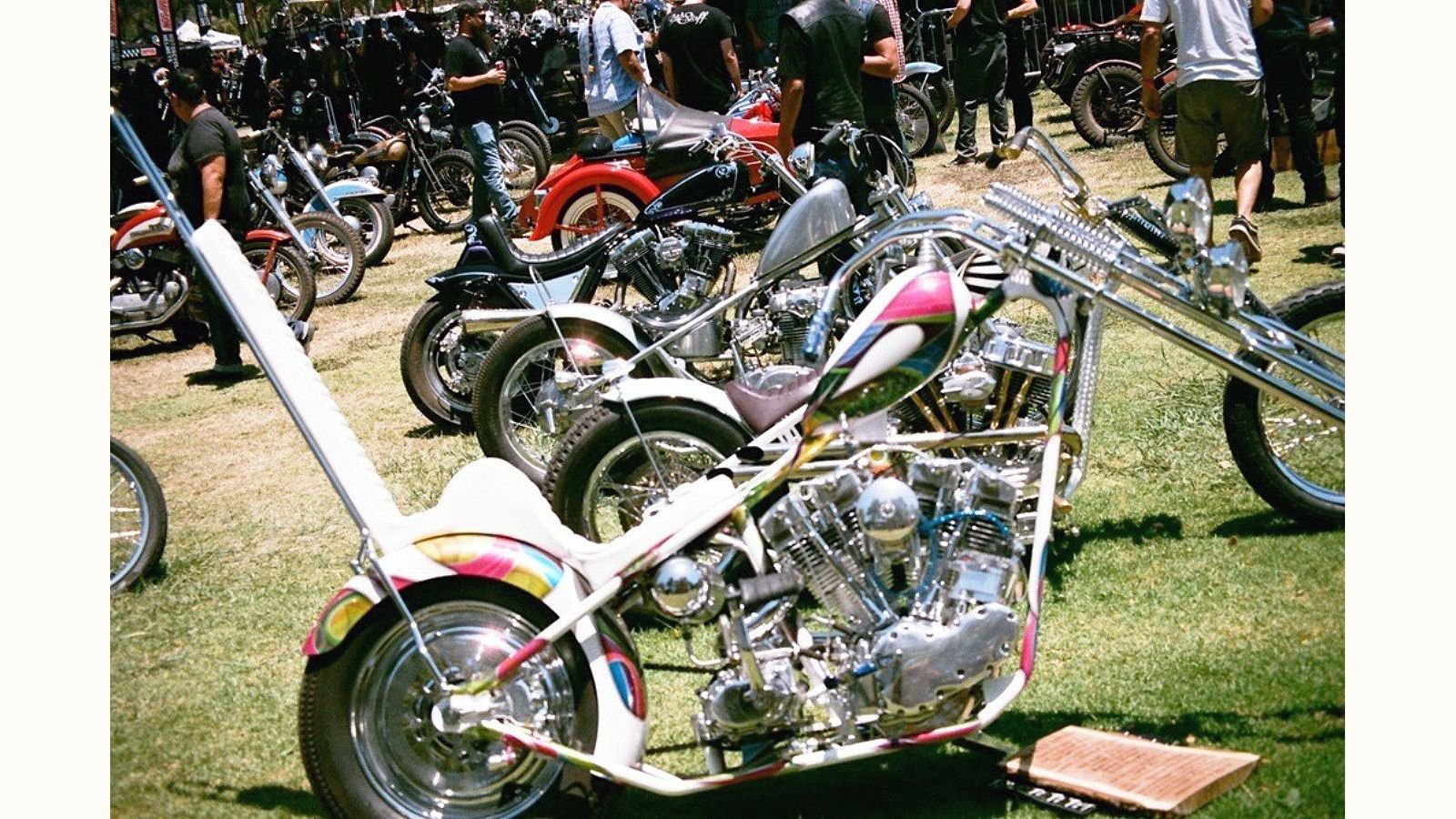The History of the Chopper in 9 Slides
Returning soldiers were not satisfied with bulky production cycles available after WWII, so they started "chopping" them. Eventually, form gave way to fashion and things got really wild.


















1. The Bob Job
There was no such thing as a chopper before WWII, and immediately after the war motorcycles were not chopped, but they were bobbed (taken from the name for chopping a dog or horses tail short). Just like hot rod car builders, biker seeking more performance from their rides would start by cutting off every bit of extra weight they could to create bobbers. The majority of racing in the United States at the time was on dirt courses, so the increased ride height and longer forks of the bikes made for the military during the war had an advantage. As speeds crept up, the angle of the steering stem was laid back for better stability. After that, it was just a matter of more, more, more, and the front ends started to grow.
2. Ed "Big Daddy" Roth's Choppers Magazine
Guys had already been chopping bike for years when hot rodder, car customizer, and cartoonist Ed "Big Daddy" Roth first published his "Choppers" magazine in 1967. Ed was used to getting stories and pictures of his way out automotive creations in car magazines, but none of the bike magazines would publish his custom bikes, or the pictures he occasionally took of outlaw bikers home built bikes. Being a real DIY kind of guy, and having made some money from the popularity of his cartoon monster, Ed invested his own money and started the first magazine dedicated to custom bikes. Now custom bike builders from all over the country could see what was going on it the local scenes thousands of miles away.
3. Builder of the Easy Rider Choppers
Benjamin "Ben" Hardy was an African American motorcycle shop owner and builder after WWII. Hardy’s Motorcycle Shop was located at 1168 E. Florence in Los Angeles. The building is still there, but today it is an auto repair shop. He and his colleague Cliff Vaughs teamed up to build the two most famous motorcycles in the world - the choppers ridden by Peter Fonda's "Captain America" and Dennis Hopper's "Billy Bike" for the 1969 movie Easy Rider. Hardy and Vaughs built two of each bike for the movie from old police Hydra Glides, bought at auction for $500. The long front ends, and many other features of the Easy Rider choppers were common in the African-American custom bike scene at the time, but Ben and Cliff did not get the recognition they deserved. If their masterpiece choppers would have been fabricated in modern times, these men may have ended up as the icons they deserve to be.
4. The Captain America Bike
Peter Fonda's machine in Easy Rider was created from a $500, 20-year old, ex-police patrol Harley-Davidson panhead and is now considered to be a national icon - after it stole the hearts of an entire generation of bikers. Easy Rider single-handedly set into motion a chopper frenzy in the motorcycle world which brought us hoards of cool choppers. Since there were no bike shops building choppers back then, the riders had to build their own.
5. 1975 Harley Davidson Panhead Chopper
The 1970's choppers became a little more refined, as more magazine promoted them, and more shops were making chopped specific parts. Notice the modifications from a stock model in the photo here: the tank is a custom made coffin shape, the front fender was removed completely, the frame is stretched out, and the contoured his-and-her seat is one piece with the back rest and follows the fender and frame.
6. 1970's Purple Chopper in a Wheelie
If the seventies brought nicer looking bikes to the bike-interested public - then watching those machines in action was even better! Just like the muscle cars and dragsters, choppers got more powerful as more recent bikes got chopped and more shops concentrated on making more power. A long front end, and a babe in the back seat makes pulling a wheelie much easier to show off to your friends.
7. Digger vs. Chopper
The long bikes of the 1970s sure looked cool, but they could get excessive and impractical. A low chopper, with an extremely raked frame, but without the super long forks was much more useful on a drag strip or freeway. These low and long bikes became known as diggers.
8. New Millenium TV Show Choppers
Fast forward to modern times... as the bike shops chimed in to build custom choppers and offer them for sale to the modern consumer, television played a role in pushing things more and more extreme. The TV show American Chopper, filmed at Orange County Choppers in upstate New York made stars out of Paul Sr. and Jr. as they built bikes like this super fine custom FBI Chopper in the early 2000's.
9. Return to Tradition
After the overblown, 2-wheeled themed parade floats of the TV show bikes, many builders went back to the basics and started building 1960s style choppers. One of the best places to see the latest looks is the annual Born Free show in southern California. Most of the bikes there reject the fat tires and gimmicks of O.C.C. and embrace the stripped down rideable bikes choppers were meant to be.
For help with service and maintenance of your bike, check out the how to section of HDForums.com

